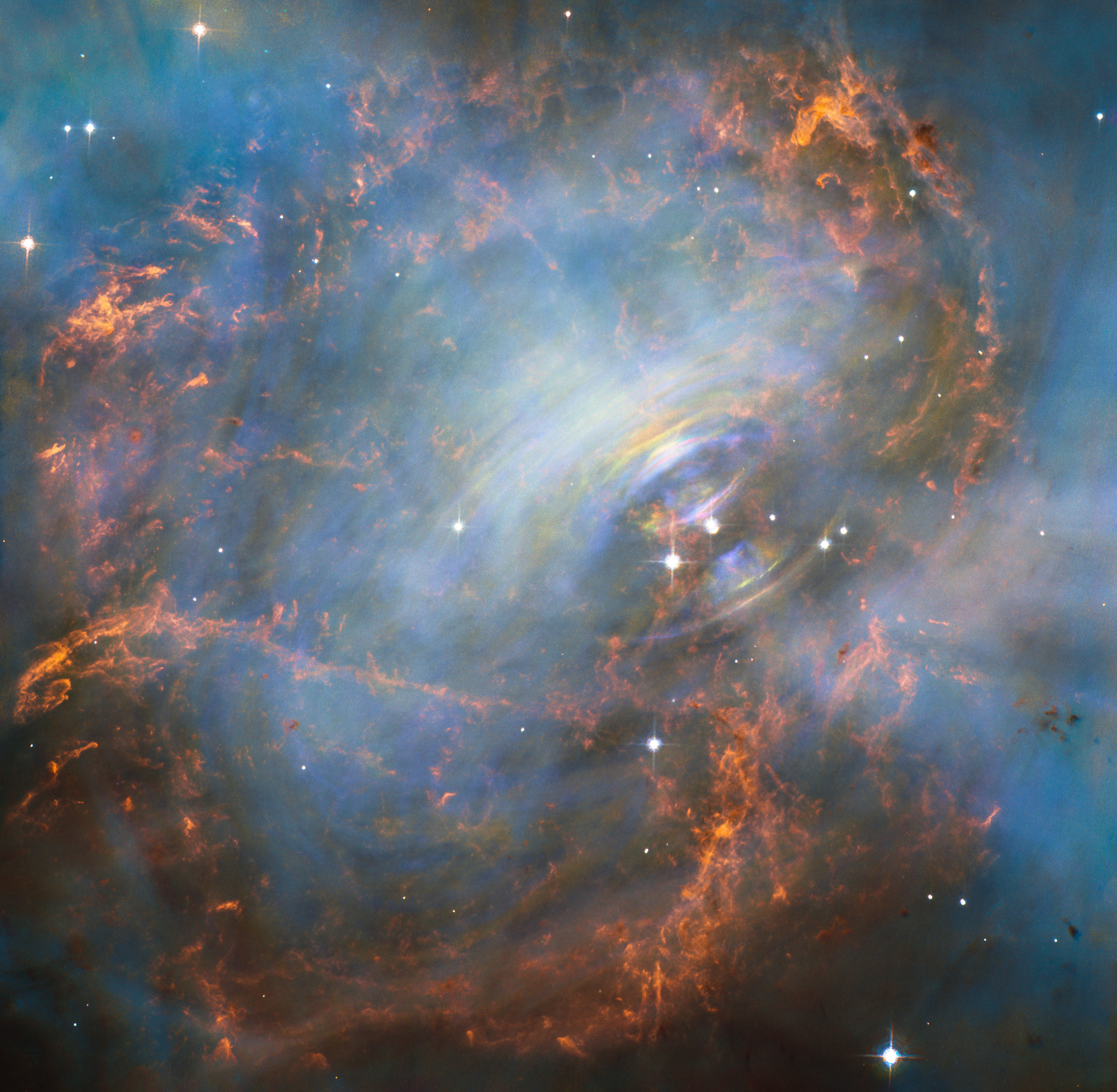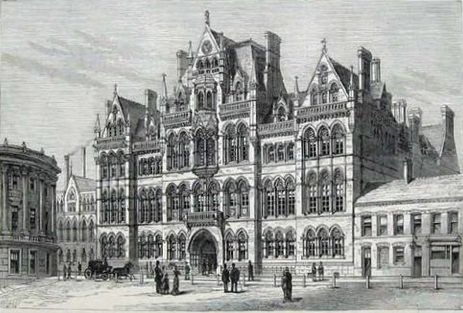|
Nuclear Astrophysics
Nuclear astrophysics studies the origin of the chemical elements and isotopes, and the role of nuclear energy generation, in cosmic sources such as stars, supernovae, novae, and violent binary-star interactions. It is an interdisciplinary part of both nuclear physics and astrophysics, involving close collaboration among researchers in various subfields of each of these fields. This includes, notably, nuclear reactions and their rates as they occur in cosmic environments, and modeling of astrophysical objects where these nuclear reactions may occur, but also considerations of cosmic evolution of isotopic and elemental composition (often called chemical evolution). Constraints from observations involve multiple messengers, all across the electromagnetic spectrum ( nuclear gamma-rays, X-rays, optical, and radio/sub-mm astronomy), as well as isotopic measurements of solar-system materials such as meteorites and their stardust inclusions, cosmic rays, material deposits on Earth and M ... [...More Info...] [...Related Items...] OR: [Wikipedia] [Google] [Baidu] |
Chemical Element
A chemical element is a chemical substance whose atoms all have the same number of protons. The number of protons is called the atomic number of that element. For example, oxygen has an atomic number of 8: each oxygen atom has 8 protons in its atomic nucleus, nucleus. Atoms of the same element can have different numbers of neutrons in their nuclei, known as isotopes of the element. Two or more atoms can combine to form molecules. Some elements form Homonuclear molecule, molecules of atoms of said element only: e.g. atoms of hydrogen (H) form Diatomic molecule, diatomic molecules (H). Chemical compounds are substances made of atoms of different elements; they can have molecular or non-molecular structure. Mixtures are materials containing different chemical substances; that means (in case of molecular substances) that they contain different types of molecules. Atoms of one element can be transformed into atoms of a different element in nuclear reactions, which change an atom's at ... [...More Info...] [...Related Items...] OR: [Wikipedia] [Google] [Baidu] |
Neutron Star
A neutron star is the gravitationally collapsed Stellar core, core of a massive supergiant star. It results from the supernova explosion of a stellar evolution#Massive star, massive star—combined with gravitational collapse—that compresses the core past white dwarf star density to that of Atomic nucleus, atomic nuclei. Surpassed only by black holes, neutron stars are the second smallest and densest known class of stellar objects. Neutron stars have a radius on the order of and a mass of about . Stars that collapse into neutron stars have a total mass of between 10 and 25 solar masses (), or possibly more for those that are especially rich in Metallicity, elements heavier than hydrogen and helium. Once formed, neutron stars no longer actively generate heat and cool over time, but they may still evolve further through Stellar collision, collisions or Accretion (astrophysics), accretion. Most of the basic models for these objects imply that they are composed almost entirely o ... [...More Info...] [...Related Items...] OR: [Wikipedia] [Google] [Baidu] |
CNO Cycle
In astrophysics, the carbon–nitrogen–oxygen (CNO) cycle, sometimes called Bethe–Weizsäcker cycle, after Hans Albrecht Bethe and Carl Friedrich von Weizsäcker, is one of the two known sets of fusion reactions by which stars convert hydrogen to helium, the other being the proton–proton chain reaction (p–p cycle), which is more efficient at the Sun's core temperature. The CNO cycle is hypothesized to be dominant in stars that are more than 1.3 times as massive as the Sun. Unlike the proton-proton reaction, which consumes all its constituents, the CNO cycle is a catalytic cycle. In the CNO cycle, four protons fuse, using carbon, nitrogen, and oxygen isotopes as catalysts, each of which is consumed at one step of the CNO cycle, but re-generated in a later step. The end product is one alpha particle (a stable helium nucleus), two positrons, and two electron neutrinos. There are various alternative paths and catalysts involved in the CNO cycles, but all thes ... [...More Info...] [...Related Items...] OR: [Wikipedia] [Google] [Baidu] |
Carl Friedrich Von Weizsäcker
Carl Friedrich Freiherr von Weizsäcker (; 28 June 1912 – 28 April 2007) was a German physicist and philosopher. He was the longest-living member of the team which performed nuclear research in Nazi Germany during the Second World War, under Werner Heisenberg's leadership. There is ongoing debate as to whether or not he and the other members of the team actively and willingly pursued the development of a nuclear bomb for Germany during this time. A member of the prominent Weizsäcker family, he was son of the diplomat Ernst von Weizsäcker, elder brother of the former German President Richard von Weizsäcker, father of the physicist and environmental researcher Ernst Ulrich von Weizsäcker and father-in-law of the former General Secretary of the World Council of Churches Konrad Raiser. Weizsäcker made important theoretical discoveries regarding energy production in stars from nuclear fusion processes. He also did influential theoretical work on planetary formation ... [...More Info...] [...Related Items...] OR: [Wikipedia] [Google] [Baidu] |
Hans Bethe
Hans Albrecht Eduard Bethe (; ; July 2, 1906 – March 6, 2005) was a German-American physicist who made major contributions to nuclear physics, astrophysics, quantum electrodynamics and solid-state physics, and received the Nobel Prize in Physics in 1967 for his work on the theory of stellar nucleosynthesis. For most of his career, Bethe was a professor at Cornell University.James C. Keck Collected Works and Biography () has the class notes taken by one of Bethe's students at Cornell from the graduate courses on Nuclear Physics and on Applications of Quantum Mechanics he taught in the spring of 1947. In 1931, Bethe developed the Bethe ansatz, which is a method for finding the exact solutions for the Eigenvalue, eigenvalues and Eigenvector, eigenvectors of certain one-dimensional quantum many-body models. In 1 ... [...More Info...] [...Related Items...] OR: [Wikipedia] [Google] [Baidu] |
The Observatory (journal)
''The Observatory'' is a publication, variously described as a journal, a magazine and a review, devoted to astronomy. It appeared regularly starting in 1877, and it is now published every two months. The current editors are David SticklandBob Argyle Steve FosseyPhillip Helbig and Quentin Stanley. Although it is not published by the Royal Astronomical Society, it publishes the reports of its meetings. Other features are the extensive book reviews, correspondence, thesis abstracts, obituaries, and "Here and There", a collection of misprints and ridiculous statements of astronomical interest. As of 2025, it is a diamond—open-access publication. The founder and first editor (1877–1882) was William Henry Mahoney Christie, William Christie, then chief assistant at the Royal Observatory, Greenwich, Royal Observatory and later Astronomer Royal. Notable subsequent editors include: * Arthur Eddington (1913–1919) * Harold Spencer Jones (1915–1923) * Richard van der Riet Woolley (1 ... [...More Info...] [...Related Items...] OR: [Wikipedia] [Google] [Baidu] |
Arthur Stanley Eddington
Sir Arthur Stanley Eddington, (28 December 1882 – 22 November 1944) was an English astronomer, physicist, and mathematician. He was also a philosopher of science and a populariser of science. The Eddington limit, the natural limit to the luminosity of stars, or the radiation generated by accretion onto a compact object, is named in his honour. Around 1920, he foreshadowed the discovery and mechanism of nuclear fusion processes in stars, in his paper "The Internal Constitution of the Stars".The Internal Constitution of the Stars A. S. Eddington The Scientific Monthly Vol. 11, No. 4 (Oct., 1920), pp. 297–303 At that time, the source of stellar energy was a complete mystery; Eddington was the first to correctly speculate that the source was fusion of hydrogen into helium. Eddington wrote a number of articles that announced and explained Einstein's theory of general relativity to the English-speaking world. World War I had severed many lines of scientific communication, and ... [...More Info...] [...Related Items...] OR: [Wikipedia] [Google] [Baidu] |
Francis William Aston
Francis William Aston FRS (1 September 1877 – 20 November 1945) was a British chemist and physicist who won the 1922 Nobel Prize in Chemistry for his discovery, by means of his mass spectrograph, of isotopes in many non-radioactive elements and for his enunciation of the whole number rule. He was a fellow of the Royal Society and Fellow of Trinity College, Cambridge. Biography Early life Francis Aston was born in Harborne, now part of Birmingham, on 1 September 1877. He was the third child and second son of William Aston and Fanny Charlotte Hollis. He was educated at the Harborne Vicarage School and later Malvern College in Worcestershire where he was a boarder. In 1893 Francis William Aston began his university studies at Mason College (which was then external college of University of London) where he was taught physics by John Henry Poynting and chemistry by Frankland and Tilden. From 1896 on he conducted additional research on organic chemistry in a private laborat ... [...More Info...] [...Related Items...] OR: [Wikipedia] [Google] [Baidu] |
James Chadwick
Sir James Chadwick (20 October 1891 – 24 July 1974) was an English nuclear physicist who received the Nobel Prize in Physics in 1935 for his discovery of the neutron. In 1941, he wrote the final draft of the MAUD Report, which inspired the U.S. government to begin serious atomic bomb research efforts. He was the head of the British team that worked on the Manhattan Project during World War II. He was knighted in Britain in 1945 for his achievements in nuclear physics. Chadwick graduated from the Victoria University of Manchester in 1911, where he studied under Ernest Rutherford (known as the "father of nuclear physics"). At Manchester, he continued to study under Rutherford until he was awarded his MSc in 1913. The same year, Chadwick was awarded an 1851 Research Fellowship from the Royal Commission for the Exhibition of 1851. He elected to study beta radiation under Hans Geiger in Berlin. Using Geiger's recently developed Geiger counter, Chadwick was able to demons ... [...More Info...] [...Related Items...] OR: [Wikipedia] [Google] [Baidu] |
Ernest Rutherford
Ernest Rutherford, 1st Baron Rutherford of Nelson (30 August 1871 – 19 October 1937) was a New Zealand physicist who was a pioneering researcher in both Atomic physics, atomic and nuclear physics. He has been described as "the father of nuclear physics", and "the greatest experimental physics, experimentalist since Michael Faraday". In 1908, he was awarded the Nobel Prize in Chemistry "for his investigations into the disintegration of the elements, and the chemistry of radioactive substances." He was the first Oceanian Nobel laureate, and the first to perform the awarded work in Canada. Rutherford's discoveries include the concept of radioactive half-life, the radioactive element radon, and the differentiation and naming of Alpha decay, alpha and Beta particle, beta radiation. Together with Thomas Royds, Rutherford is credited with proving that alpha radiation is composed of helium nuclei. In 1911, he theorized that atoms have their charge concentrated in a very small atomi ... [...More Info...] [...Related Items...] OR: [Wikipedia] [Google] [Baidu] |
Atomic Nucleus
The atomic nucleus is the small, dense region consisting of protons and neutrons at the center of an atom, discovered in 1911 by Ernest Rutherford at the Department_of_Physics_and_Astronomy,_University_of_Manchester , University of Manchester based on the 1909 Geiger–Marsden experiments, Geiger–Marsden gold foil experiment. After the discovery of the neutron in 1932, models for a nucleus composed of protons and neutrons were quickly developed by Dmitri Ivanenko and Werner Heisenberg. An atom is composed of a positively charged nucleus, with a cloud of negatively charged electrons surrounding it, bound together by electrostatic force. Almost all of the mass of an atom is located in the nucleus, with a very small contribution from the electron cloud. Protons and neutrons are bound together to form a nucleus by the nuclear force. The diameter of the nucleus is in the range of () for hydrogen (the diameter of a single proton) to about for uranium. These dimensions are much ... [...More Info...] [...Related Items...] OR: [Wikipedia] [Google] [Baidu] |






